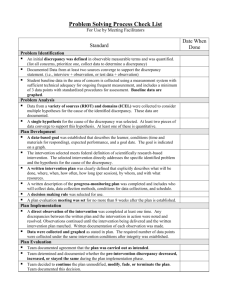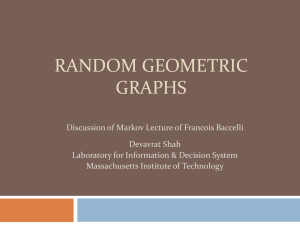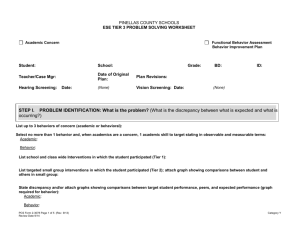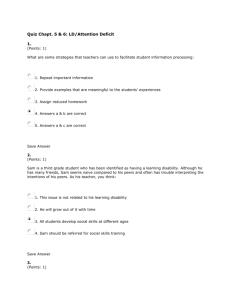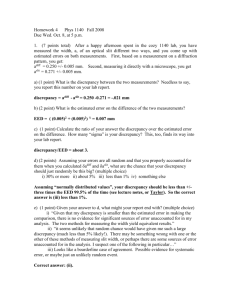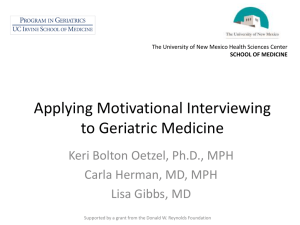On the Erdos Discrepancy Conjecture for Completely Multiplicative
advertisement
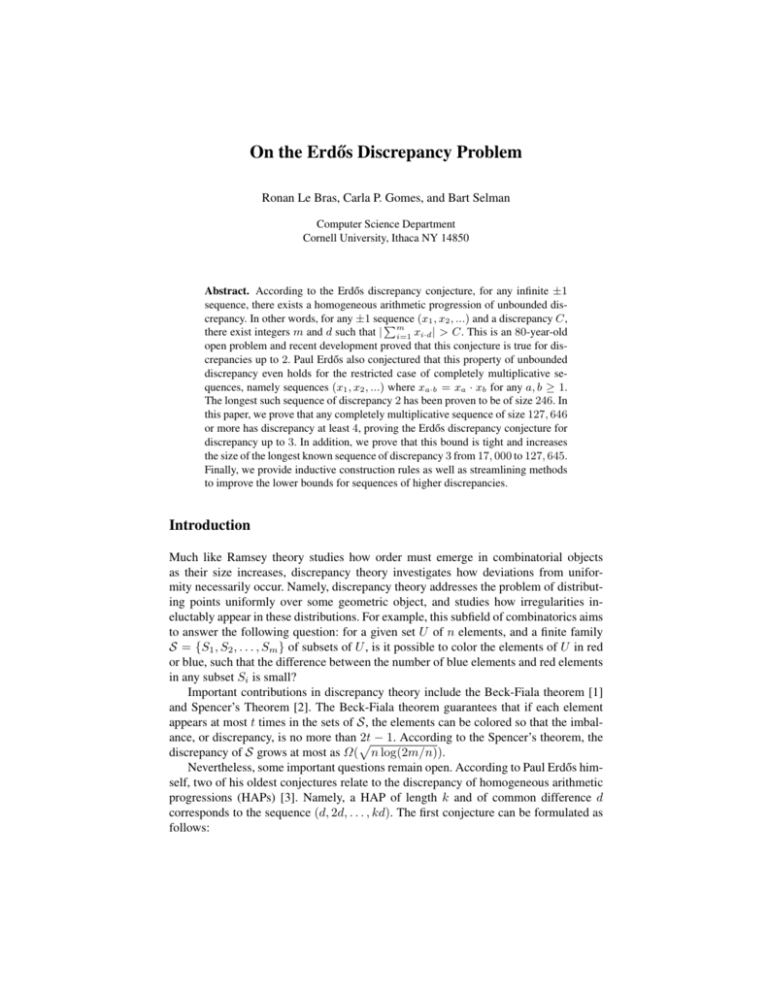
On the Erdős Discrepancy Problem
Ronan Le Bras, Carla P. Gomes, and Bart Selman
Computer Science Department
Cornell University, Ithaca NY 14850
Abstract. According to the Erdős discrepancy conjecture, for any infinite ±1
sequence, there exists a homogeneous arithmetic progression of unbounded discrepancy. In other words, for any ±1 sequence
(x1 , x2 , ...) and a discrepancy C,
P
there exist integers m and d such that | m
i=1 xi·d | > C. This is an 80-year-old
open problem and recent development proved that this conjecture is true for discrepancies up to 2. Paul Erdős also conjectured that this property of unbounded
discrepancy even holds for the restricted case of completely multiplicative sequences, namely sequences (x1 , x2 , ...) where xa·b = xa · xb for any a, b ≥ 1.
The longest such sequence of discrepancy 2 has been proven to be of size 246. In
this paper, we prove that any completely multiplicative sequence of size 127, 646
or more has discrepancy at least 4, proving the Erdős discrepancy conjecture for
discrepancy up to 3. In addition, we prove that this bound is tight and increases
the size of the longest known sequence of discrepancy 3 from 17, 000 to 127, 645.
Finally, we provide inductive construction rules as well as streamlining methods
to improve the lower bounds for sequences of higher discrepancies.
Introduction
Much like Ramsey theory studies how order must emerge in combinatorial objects
as their size increases, discrepancy theory investigates how deviations from uniformity necessarily occur. Namely, discrepancy theory addresses the problem of distributing points uniformly over some geometric object, and studies how irregularities ineluctably appear in these distributions. For example, this subfield of combinatorics aims
to answer the following question: for a given set U of n elements, and a finite family
S = {S1 , S2 , . . . , Sm } of subsets of U , is it possible to color the elements of U in red
or blue, such that the difference between the number of blue elements and red elements
in any subset Si is small?
Important contributions in discrepancy theory include the Beck-Fiala theorem [1]
and Spencer’s Theorem [2]. The Beck-Fiala theorem guarantees that if each element
appears at most t times in the sets of S, the elements can be colored so that the imbalance, or discrepancy, is no more than p
2t − 1. According to the Spencer’s theorem, the
discrepancy of S grows at most as Ω( n log(2m/n)).
Nevertheless, some important questions remain open. According to Paul Erdős himself, two of his oldest conjectures relate to the discrepancy of homogeneous arithmetic
progressions (HAPs) [3]. Namely, a HAP of length k and of common difference d
corresponds to the sequence (d, 2d, . . . , kd). The first conjecture can be formulated as
follows:
2
Conjecture 1. Let (x1 , x2 , ...) be an arbitrary ±1 sequence. The discrepancy of x w.r.t.
HAPs mustPbe unbounded, i.e. for any integer C there is an integer m and an integer d
m
such that | i=1 xi·d | > C.
This problem has been open for over eighty years, as is the weaker form according
to which one can restrict oneself to completely multiplicative functions. Namely, f is
a completely multiplicative function if f (a · b) = f (a) · f (b) for any a, b. The second
conjecture translates to:
Conjecture 2. Let (x1 , x2 , ...) be an arbitrary completely multiplicative ±1 sequence.
The discrepancy of xP
w.r.t. HAPs must be unbounded, i.e. for any integer C there is a
m
m and a d such that | i=1 xi·d | > C.
Hereinafter, when non-ambiguous, we refer to the discrepancy of a sequence as its
discrepancy with respect
Pmto homogeneous arithmetic progressions. Formally, we denote
disc(x) = maxm,d | i=1 xi·d |. We denote E1 (C) the minimum length for which any
sequence has discrepancy at least C + 1, or equivalently, one plus the maximum length
of a sequence of discrepancy C. Similarly, we define E2 (C) the minimum length for
which any completely multiplicative sequence has discrepancy at least C + 1. 1
C
1
E1 (C) 12
E2 (C) 10
2
3
1,161
247
≥127,646
127,646
Table 1: Results for the Erdős discrepancy problem. E1 (C) (resp. E2 (C)) corresponds to
the minimum length for which any sequence (resp. completely multiplicative sequence)
has discrepancy C + 1. Bold indicates contribution of the current work.
A proof or disproof of these conjectures would constitute a major advancement in
combinatorial number theory [4]. To date, both conjectures have been proven to hold
for the case C ≤ 2. As illustrated in Table 1, the values of E1 (1), E2 (1), and E2 (2) have
been long proven to be 12, 10, and 247 respectively, while recent development proved
E1 (2) = 1161 [5]. Konev and Lisitsa [5] also provide a new lower bound for E1 (3).
After 3 days of computation, a SAT solver was able to find a satisfying assignment for a
sequence of length 13, 000. Yet, it would fail to find a solution of size 14, 000 in over 2
weeks of computation. They also report a solution of length 17, 000, the longest known
sequence of discrepancy 3.
In this work, we explore streamlining for this problem, an effective combinatorial
search strategy that exploits regularities in some problem solutions, beyond the structure of the combinatorial problem itself. Streamlining provides and exploits structural
information about the problem, and we believe that a sine qua non condition for tackling huge sequences requires deep insights into the structure of the problem. In addition,
streamlining provides a vision for a broader strategy for solving problems. Overall, we
1
Note that, if Conjecture 1 (resp. Conjecture 2) were to be rejected, E1 (C) (resp. E2 (C) ) would
correspond to infinity.
3
substantially increase the size of the longest sequence of discrepancy 3, from 17, 000
to 127, 645. In addition, we prove that E2 (3) = 127, 646, making this bound tight, as
Plingeling was able to prove unsat and Lingeling generated an UNSAT proof
in DRUP format [6].
This paper is organized as follows. The next section formally defines the Erdős
discrepancy problems (for the general case and the multiplicative case) and presents
SAT encodings for both problems. We then investigate streamlined search techniques to
boost the search for lower bounds of these two problems, and to characterize additional
structures that appear in a subset of the solutions. Furthermore, in a subsequent section,
we provide construction rules that are based on these streamliners and allow to generate
larger sequences of limited discrepancy from smaller ones. The last section presents the
results of these approaches.
Problem Formulation
In this section, we first formally define the two conjectures as decision problems and
then propose encodings for these problems.
Definition 1 (EDP1 ). Given
Pm two integers n and C, does there exist a ±1 sequence
(x1 , . . . , xn ) such that | i=1 xi·d | ≤ C for any 1 ≤ d ≤ n, m ≤ n/d.
Konev and Lisitsa [5] provide a SAT encoding for this problem that uses an automaton accepting any sub-sequence of discrepancy exceeding C. A state sj of the
automaton corresponds to the sum of the input sequence, while the accepting state
sB captures whether the sequence has exceeded the discrepancy C. A proposition
Pm−1
(m,d)
sj
is true whenever the automaton is in state i=1 xi·d after reading the sequence
(xd , . . . , x(m−1)d ). Let pi be the proposition corresponding to xi = +1. A proposition
that tracks the state of the automaton for an input sequence (xd , x2d , . . . , xbn/dcd ) can
be formulated as:
n/d
(1,d)
φ(n, C, d) = s0
^ m=1
^
(m+1,d) (m,d)
∧ pid → sj+1
(m,d)
∧ pid → sj+1
sj
∧
−C≤j<C
^
sj
(m+1,d) ∧
−C<j≤C
(m,d)
∧ pid → sB ∧
(m,d)
s−C ∧ pid → sB
sC
(1)
In addition, we need to encode that the automaton is in exactly one state at any point
in time. Formally, we define this proposition as:
χ(n, C) =
^
1≤d≤n/C,1≤m≤n/d
_
−C≤j≤C
(i,d)
sj
∧
^
−C≤j1 ,j2 ≤C
(i,d)
sj1
(i,d) ∨ sj2
(2)
4
Finally, we can encode the Erdős Discrepancy Problem as follows:
EDP1 (n, C) : sB ∧ χ(n, C) ∧
n
^
φ(n, C, d)
(3)
d=1
(m,d)
Furthermore, as the authors of [5], the actual states sj
of the automaton do not
require 2C + 1 binary variables to represent the 2C + 1 values of the states. Instead,
one can modify this formulation and use dlog2 (2C + 1)e binary variables to encode the
automaton states.
For the completely multiplicative case, we introduce additional constraints to capture the multiplicative property of any element of the sequence, i.e. xid = xi xd for any
1 ≤ d ≤ n, 1 ≤ i ≤ n/d. With respect to the boolean variables pi , pd and pid , such a
constraint acts as XNOR gate of input pi and pd and of output pid . Formally, we denote
this proposition M(i, d) and define:
M(i, d) = (pi ∨ pd ∨ pid ) ∧ (pi ∨ pd ∨ pid ) ∧ (pi ∨ pd ∨ pid ) ∧ (pi ∨ pd ∨ pid )
(4)
Importantly, for completely multiplicative sequences, the discrepancy of the subsequence (xd , ..., xmd ) of length m and common difference d will bePthe same as
m
the
discrepancy of the P
subsequence (x
Pm
P1m, ..., xm ). Indeed , we have | i=1 xi·d | =
m
| i=1 xi xd | = |x
| · | i=1 xi | = | i=1 xi |. Therefore, one needs only check that
Pdm
the partial sums i=1 xi , 1 ≤ m ≤ n never exceed C nor go below −C. Furthermore, note that a completely multiplicative sequence is entirely characterized by the
values it takes at prime positions, i.e. {xp |p is prime}. In addition, if there exists a completely multiplicative sequence (x1 , ..., xp−1 ) of discrepancy C with p prime, then the
1Pm
sequence (x1 , ..., xp−1 , (−1) i=1 xi ≥0 ) will also be a CMS of discrepancy C. As a
result, E 2 (C) cannot be a prime number.
Overall, for the completely multiplicative case, we obtain:
^
M(i, d)
(5)
EDP2 (n, C) : sB ∧ χ(n, C) ∧ φ(n, C, 1)
1≤d≤n,1≤i≤n/d
Streamlined Search
The encoding of EDP1 given in the previous section has successfully led to prove a
tight bound for the case C = 2 [5]. On an Intel Core i5-2500K CPU, it takes about 800
seconds for Plingeling [7] to find a satisfying assignment for EDP1 (1160, 2) and
less than 6 hours for Glucose [8] to generate a proof of E1 (2) = 1, 161. Nevertheless,
for the case C = 3, it requires more than 3 days of computation for Plingeling to
find a sequence of size n = 13, 000, and fails to find a sequence of size 14, 000 in over
two weeks of computation.
In this section, in order to improve this lower bound and acquire a better understanding of the solution space, we explore streamlining techniques that identifies additional
5
structure occurring in a subset of the solutions. Among the solutions of a combinatorial problem, there might be solutions that possess regularities beyond the structure of
the combinatorial problem itself. Streamlining [9] is an effective combinatorial search
strategy that exploits these additional regularities. By intentionally imposing additional
structure to a combinatorial problem, it focuses the search on a highly structured subspace and triggers increased constraint reasoning and propagation. This search technique is sometimes referred to as “tunneling” [10]. In other words, a streamlined search
consists in adding specific desired or observed regularities, such as a partial pattern that
appears in a solution, to the combinatorial solver. These additional regularities boost
the solver that may find more effectively larger solutions that contain these regularities.
If no solution is found, the observed regularities were likely accidental. Otherwise, one
can analyze these new solutions and suggests new regularities. This methodology has
been successfully applied to find efficient constructions for different combinatorial objects, such as spatially-balanced Latin squares [11], or graceful double-wheel graphs
[12].
When analyzing solutions of EDP1 (n, 2) for n ∈ [1, 1160], there is a feature that
visually stands out of the solutions, as illustrated in Figure 1. When looking at a solution
as a 2D-matrix with entries in {−, +} and changing the dimensions of the matrix (see
Fig. 1, Left) , there seems to be clear preferred matrix dimensions (say m-by-p) such
that the m rows are mostly identical for the columns 1 to p − 1, suggesting that xi =
xi mod p for 1 ≤ i ≤ p − 1. We denote period(x, p, t) the streamliner that enforces this
observation and define:
period(x, p, t) : xi = xi mod p ∀1 ≤ i ≤ t, i 6≡ 0 mod p
(6)
Fig. 1: First elements of a sequence of length 1160 and of discrepancy 2, illustrating the
period (Left) and mult (Right) streamliners.
First, while this observation by itself did not allow to improve the current best lower
bound for E1 (3), it led to the formulation of the construction of the next section. Second,
it also led to the re-discovery of the so-called ’improved Walters sequence’ [13], defined
as follows:
if i is 1 mod 3
+1,
µ3 (i) = −1,
(7)
if i is 2 mod 3
−µ3 (i/3), otherwise.
6
In the following, we denote walters(x, w) the streamliner imposing that the first w
elements of a sequence x follow the improved Walters sequence, i.e.:
walters(x, w) : xi = µ3 (i) ∀1 ≤ i ≤ w
(8)
One can easily see that the improved Walters sequence is a special case of the periodic sequence defined previously. Namely, for any sequence x where walters(x, w)
holds true, then we have period(x, 9, w).
Finally, another striking feature of the solutions of EDP1 (n, 2) is that they tend
to follow a multiplicative sequence. Interestingly, EDP2 restricts EDP1 to the special
case of multiplicative functions and we observe for the case C = 2 that this restriction
substantially impacts the value of the best bound possible (i.e. E1 (2) = 1, 161 whereas
E2 (2) = 247). Nevertheless, the solutions of EDP1 (n, 2) exhibit a partial multiplicative
property (see Fig. 1, Right) and we define:
mult(x, m, l) : xi·d = xi xd ∀2 ≤ d ≤ m, 1 ≤ i ≤ n/d, i ≤ l
(9)
In the experimental section, we show the speed-ups that are triggered using these
streamliners, and how the best lower bound for EDP1 (n, 2) gets greatly improved.
Construction Rule
In this section, we show how we used insights from the period(x, p, t) streamliner in
order to generate an inductive construction rule for sequences of discrepancy C from
sequences of lower discrepancy.
Consider a sequence x that is periodic of period p, as defined in the previous section,
i.e. period(x, p, |x|) holds true, and is of length n = p ∗ k. Then, the sequence x can be
written as:
x = (y1 , y2 , . . . , yp−2 , yp−1 , z1
y1 , y2 , . . . , yp−2 , yp−1 , z2
...
y1 , y2 , . . . , yp−2 , yp−1 , zk )
(10)
0
Let C be
discrepancy
Pthe
Pm of z = (z1 , z2 , ..., zk ) and C the discrepancy of (y1 , ..., yp−1 ).
m
Given that i=1 xip = i=1 zi for any 1 ≤ m ≤ k, we have disc(x) ≥ C. Note that
if x was completely multiplicative, then it would hold disc(x) = C. We study the general case where x is not necessarily multiplicative, and investigate the conditions under
which disc(x) is guaranteed to be less or equal to C + C 0 .
For a given common difference d and length m, we consider the subsequence
p
(xd , x2d , ..., xmd ). Let q = gcd(d,p)
. Given the definition 10 of x, we have:
(xd , x2d , ..., xmd ) = (yd mod p , y2d mod p , ..., y(q−1)d mod p , zq ,
(11)
yd mod p , y2d mod p , ..., y(q−1)d mod p , z2q ,
(12)
yd mod p , ...)
(13)
7
Note that if p divides d or d divides p, this subsequence becomes (zq , z2q , ..., zqm )
and is of discrepancy at most C. As a result, a sufficient condition for x to be of discrepancy at most C + C 0 is to have yd mod p , y2d mod p , ..., y(q−1)d mod p of discrepancy
C 0 and summing to 0. We say that such a sequence has a discrepancy mod p of C 0 .
Formally, we define the problem of finding such sequences as follows:
Definition 2 (Discrepancy mod p). Given two integers p and C 0 , does there exist a ±1
sequence (y1 , . . . , yp−1 ) such that:
|
m
X
yi·d mod p | ≤ C 0 , ∀1 ≤ d ≤ n, m <
i=1
p
gcd(d, p)
(14)
p
−1
gcd(d,p)
X
yi·d mod p = 0, ∀1 ≤ d ≤ n
(15)
i=1
Notice that, given the equation 15, p should be odd for such a sequence to exist.
We encode this problem as a Constraint Satisfaction Problem (CSP) in a natural way
from the problem definition. We provide the experimental results in the next section.
Results
All experiments were run on a Linux (version 2.6.18) cluster where each node has an
Intel Xeon Processor X5670, with dual-CPU, hex-core @2.93GHz, 12M Cache, 48GB
RAM. Unless otherwise noted, the results were obtained using the parallel SAT solver
Plingeling, version ats1 for the SAT encodings, and using IBM ILOG CPLEX
CP Optimizer, release 12.5.1 for the CP encodings.
First, we evaluate the proposed streamliners for the two problems. Table 2 reports
the length of the sequences that were successfully generated, as well as the computation
time. The first clear observation is that, for EDP1 , the streamlined search based on the
partial multiplicative property significantly boosts the search and allows to generate
solutions that appear to be out of reach of the standard search approach. For example,
while it takes about 10 days to find a solution of length 13, 900 without streamliners, the
streamlined search generates a substantially-large satisfying assignment of size 31, 500
in about 15 hours. Next, we study streamliners that were used for EDP2 , i.e. partially
imposing the walters sequence. The results clearly show the speed up triggered by the
combination of the new encoding for EDP2 with the walters streamliners. Interestingly,
the longest walters sequence of discrepancy 3 is of size 819. Nevertheless, one can
successfully impose the first 800 elements of the walters sequence and still expand it to
a sequence of length 108, 000. Furthermore, when imposing walters(730), it takes less
than 1 hour and an half to find a satisfying assignment for a sequence of size 127, 645.
Moreover, without additional streamliners, it takes about 60 hours to prove unsat for the
case 127, 646 and allows us to prove that this bound is tight. Indeed, the solver generates
a DRUP proof of approximately 29GB and DRAT-trim, an independent satisfiability
proof checker [6, 14], verifies the 88 million lemmas of the proof in about 45 hours.
In terms of the inductive construction described in the previous section, we can generate sequences whose discrepancy mod p is 1, for p in 1, 3, 5, 7, and 9, while it also
8
Encoding
Streamliners
Size of sequence Runtime (in sec)
EDP1
mult(120,2000)
mult(150,2000)
mult(200,1000)
mult(700,10000)
mult(700,20000)
13,000
13,500
13,900
15,600
18,800
23,900
27,000
31,500
286,247
560,663
770,122
4,535
8,744
12,608
45,773
51,144
EDP2
walters(800)
walters(800)
walters(700)
walters(730)
81,000
108,000
112,000
127,645
1,364
4,333
5,459
4,501
Table 2: Solution runtimes of searches with and without streamliners. The streamlined
search leads to new lower bounds for the 2 EDP problems.
generates sequences of discrepancy mod p equal to 2 for p in 11, 13, 15, 17, 25, 27, 45,
and 81. Overall, this proves that one can take any sequence x of length |x| and discrepancy C and generate one of length 9|x| and of discrepancy C + 1, or of length
81|x| and of discrepancy C + 2. As a result, this provides a new bound for the case
of discrepancy 4, and proves E1 (4) > 9 ∗ 127645 = 1, 148, 805. Interestingly, such a
long sequence suggests that the proof of the Erdos conjecture for C > 3 may require
additional insights and analytical proof, beyond the approach proposed in this work.
Conclusions
In this paper, we address the Erdős discrepancy problem for general sequences as well
as for completely multiplicative sequences. We adapt a SAT encoding previously proposed and investigate streamlining methods to speed up the solving time and understand additional structures that occur in some solutions. Overall, we substantially improve the best known lower bound for discrepancy 3 from 17, 001 to 127, 646. In addition, we prove that this bound is tight, as evidenced by the unsat proof generated by
Lingeling and confirmed by the proof checker DRAT-trim. Finally, we propose
construction rules to inductively generate longer sequences of limited discrepancy.
Acknowledgments
This work was supported by the National Science Foundation (NSF IIS award, grant 1344201).
The experiments were run on an infrastructure supported by the NSF Computing research infrastructure for Computational Sustainability grant (grant 1059284). Note that, while this work
was submitted on April 14, 2014 to the 20th International Conference on Principles and Practice of Constraint Programming, results [15] were independently submitted on May 13, 2014,
confirming the value of E2 (3).
9
References
1. Beck, J., Fiala, T.: integer-making theorems. Discrete Applied Mathematics 3 (1981) 1–8
2. Spencer, J.: Six standard deviations suffice. Transactions of the American Mathematical
Society 289 (1985) 679–706
3. Erdös, P.: Some of my favourite problems which recently have been solved. North-Holland
Mathematics Studies 74 (1982) 59–79
4. Nikolov, A., Talwar, K.: On the hereditary discrepancy of homogeneous arithmetic progressions. arXiv preprint arXiv:1309.6034 (2013)
5. Konev, B., Lisitsa, A.: A sat attack on the erdos discrepancy conjecture. (2014)
6. Heule, M.J., Hunt, W.A., Wetzler, N.: Trimming while checking clausal proofs. In: Formal
Methods in Computer-Aided Design (FMCAD), 2013, IEEE (2013) 181–188
7. Biere, A.: Lingeling, plingeling and treengeling entering the sat competition 2013. Proceedings of SAT Competition 2013; Solver and (2013) 51
8. Audemard, G., Simon, L.: Glucose 2.3 in the sat 2013 competition. Proceedings of SAT
Competition 2013; Solver and (2013) 42
9. Gomes, C.P., Sellmann, M.: Streamlined constraint reasoning. In: CP. (2004) 274–289
10. Kouril, M., Franco, J.: Resolution tunnels for improved sat solver performance. In: In Proc.
of 8th International Conference on Theory and Applications of Satisfiability Testing. (2005)
143–157
11. Le Bras, R., Gomes, C.P., Selman, B.: From streamlined combinatorial search to efficient
constructive procedures. In: Proceedings of the 15th international conference on Artificial
Intelligence. AAAI’12 (2012)
12. Le Bras, R., Gomes, C.P., Selman, B.: Double-wheel graphs are graceful. In: Proceedings of
the Twenty-Third International Joint Conference on Artificial Intelligence. IJCAI’13, AAAI
Press (2013) 587–593
13. Polymath1: Matryoshka Sequences, http://michaelnielsen.org/polymath1/
index.php?title=Matryoshka_Sequences. (accessed April 11, 2014)
14. Wetzler, N., Heule, M.J., Hunt Jr, W.A.: (Drat-trim: Efficient checking and trimming using
expressive clausal proofs)
15. Konev, B., Lisitsa, A.: Computer-aided proof of erdos discrepancy properties. arXiv preprint
arXiv:1405.3097 (2014)

